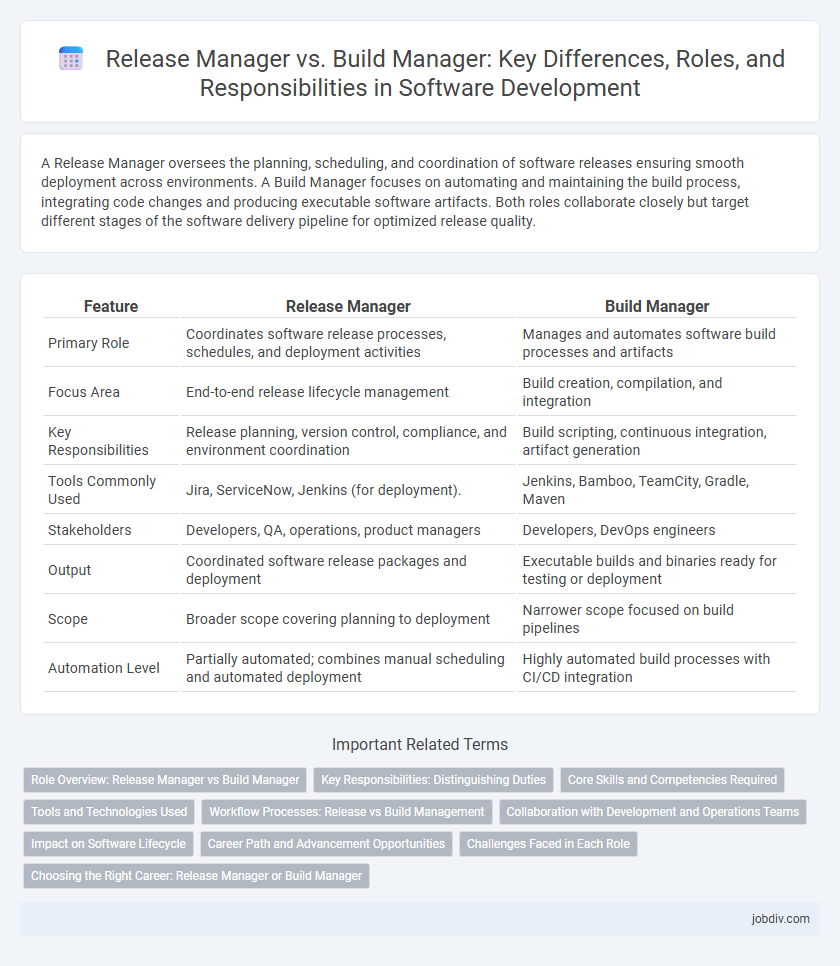A Release Manager oversees the planning, scheduling, and coordination of software releases ensuring smooth deployment across environments. A Build Manager focuses on automating and maintaining the build process, integrating code changes and producing executable software artifacts. Both roles collaborate closely but target different stages of the software delivery pipeline for optimized release quality.
Table of Comparison
| Feature | Release Manager | Build Manager |
|---|---|---|
| Primary Role | Coordinates software release processes, schedules, and deployment activities | Manages and automates software build processes and artifacts |
| Focus Area | End-to-end release lifecycle management | Build creation, compilation, and integration |
| Key Responsibilities | Release planning, version control, compliance, and environment coordination | Build scripting, continuous integration, artifact generation |
| Tools Commonly Used | Jira, ServiceNow, Jenkins (for deployment). | Jenkins, Bamboo, TeamCity, Gradle, Maven |
| Stakeholders | Developers, QA, operations, product managers | Developers, DevOps engineers |
| Output | Coordinated software release packages and deployment | Executable builds and binaries ready for testing or deployment |
| Scope | Broader scope covering planning to deployment | Narrower scope focused on build pipelines |
| Automation Level | Partially automated; combines manual scheduling and automated deployment | Highly automated build processes with CI/CD integration |
Role Overview: Release Manager vs Build Manager
The Release Manager oversees the deployment process, ensuring software releases are delivered on schedule and meet quality standards by coordinating cross-functional teams and managing release timelines. The Build Manager focuses on the automation, integration, and maintenance of build processes, ensuring code compiles correctly and that continuous integration pipelines run smoothly. Both roles are critical in DevOps, with the Release Manager emphasizing release readiness and delivery, while the Build Manager ensures stable and reliable build environments.
Key Responsibilities: Distinguishing Duties
The Release Manager oversees the end-to-end release process, coordinating deployment schedules, ensuring compliance with quality standards, and managing risk mitigation strategies across multiple environments. The Build Manager concentrates on compiling source code, integrating software components, maintaining build automation systems, and ensuring build stability and reproducibility. Distinguishing duties highlight the Release Manager's focus on deployment orchestration and stakeholder communication, while the Build Manager specializes in technical execution of build pipelines and continuous integration workflows.
Core Skills and Competencies Required
Release Managers require strong expertise in version control systems, deployment automation, and cross-functional team coordination to ensure smooth software delivery cycles. Build Managers must excel in build automation tools, continuous integration pipelines, and troubleshooting compilation or dependency issues to maintain stable and efficient build environments. Both roles demand problem-solving skills, attention to detail, and proficiency in scripting languages such as Python or Bash to optimize workflows and streamline processes.
Tools and Technologies Used
Release Managers primarily utilize tools like Jenkins, Bamboo, and Azure DevOps to automate deployment pipelines and manage release cycles effectively. Build Managers focus on build automation technologies such as Maven, Gradle, and Ant to compile code, run tests, and generate build artifacts. Both roles leverage version control systems like Git and integrate with continuous integration/continuous delivery (CI/CD) platforms to ensure seamless software delivery.
Workflow Processes: Release vs Build Management
Release Managers coordinate deployment schedules, version control, and environment promotions to ensure smooth software delivery, emphasizing end-to-end release lifecycle management. Build Managers focus on automating compilation, integration, and packaging workflows, optimizing continuous integration pipelines for efficient and error-free software builds. Both roles synchronize closely, yet Release Managers oversee broader deployment orchestration while Build Managers specialize in maintaining build integrity and automation processes.
Collaboration with Development and Operations Teams
Release Managers coordinate closely with development teams to schedule and validate software releases while aligning with operations for deployment stability and rollback plans. Build Managers collaborate primarily with development teams to automate build processes, integrate code changes, and ensure continuous integration pipelines run smoothly. Both roles require effective communication and toolchain integration to bridge development and operations, enabling streamlined DevOps workflows and faster delivery cycles.
Impact on Software Lifecycle
Release Managers streamline deployment processes and ensure coordinated software launches, directly improving release frequency and reducing downtime. Build Managers optimize build automation and integration, enhancing code quality and accelerating development cycles. Both roles collaboratively impact the software lifecycle by enabling continuous integration and continuous delivery (CI/CD) practices, leading to faster, more reliable software releases.
Career Path and Advancement Opportunities
Release Manager roles emphasize coordinating software deployment and aligning cross-functional teams, offering clear advancement into senior project or product management positions. Build Managers often specialize in automation and continuous integration pipelines, providing career growth opportunities toward DevOps engineering or infrastructure architecture. Both paths demand strong technical skills, but Release Managers typically move into strategic leadership roles, whereas Build Managers advance through increasingly technical specialties.
Challenges Faced in Each Role
Release Managers often face challenges in coordinating cross-functional teams to ensure timely software deployment while managing dependencies and mitigating risks associated with environment inconsistencies. Build Managers encounter difficulties in maintaining efficient build pipelines, handling integration conflicts, and troubleshooting build failures caused by codebase changes or toolchain issues. Both roles require robust communication and problem-solving skills to address these technical obstacles and ensure smooth software delivery processes.
Choosing the Right Career: Release Manager or Build Manager
Choosing between a Release Manager and a Build Manager career depends on your strength in coordinating software deployment cycles versus managing automated build systems. Release Managers specialize in overseeing the release process, ensuring timely, quality delivery across multiple environments, whereas Build Managers focus on maintaining continuous integration pipelines and optimizing build automation tools. Prioritizing expertise in project coordination and stakeholder communication aligns with a Release Manager role, while strong skills in scripting, build tools like Jenkins or Bamboo, and version control are critical for Build Managers.
Release Manager vs Build Manager Infographic

 jobdiv.com
jobdiv.com